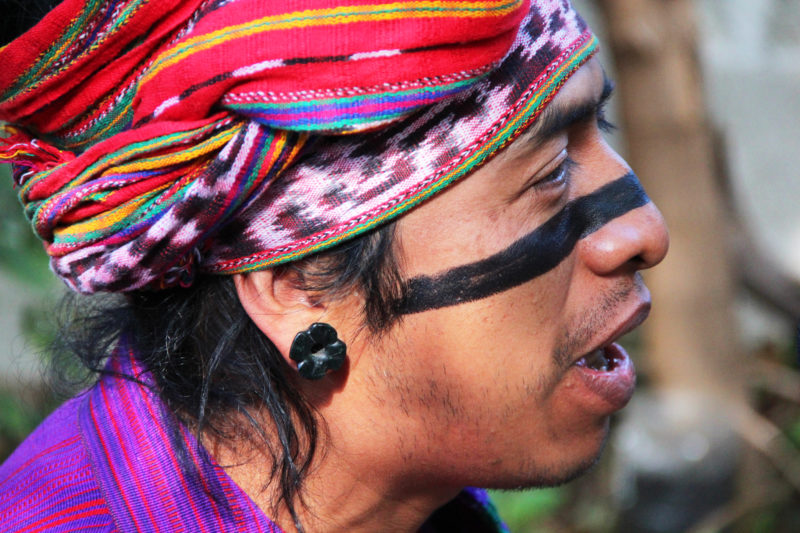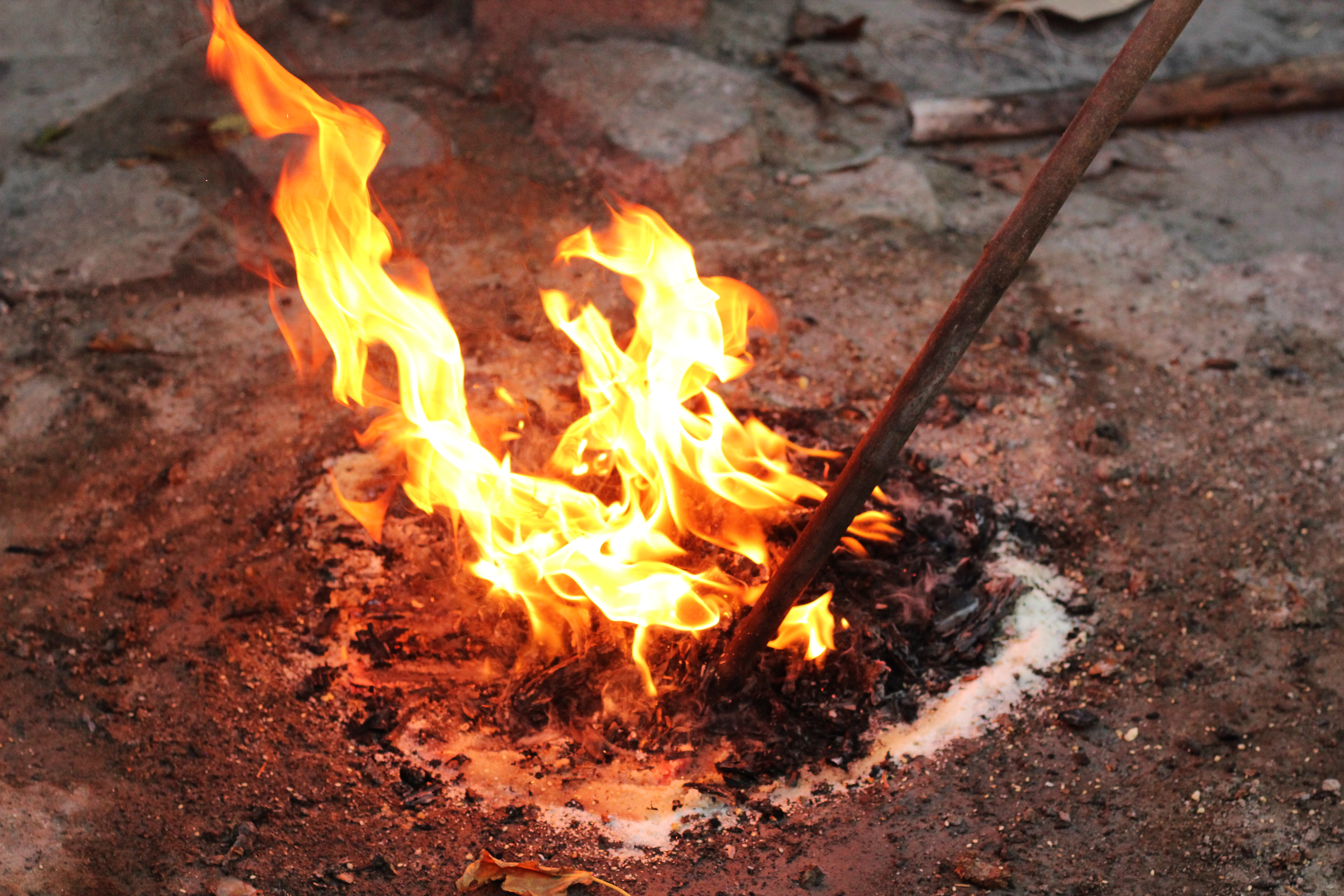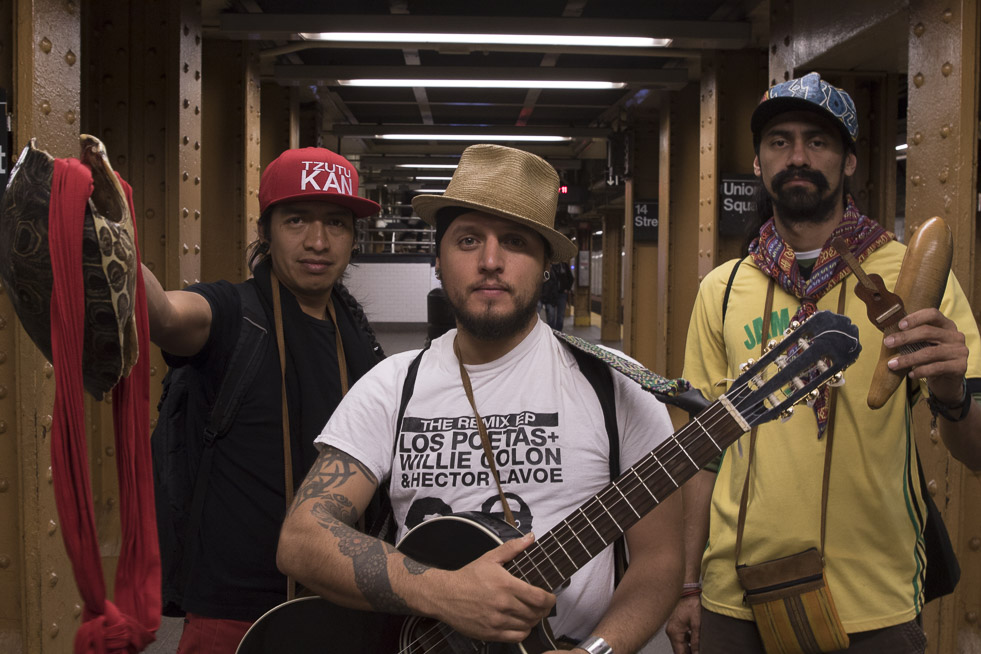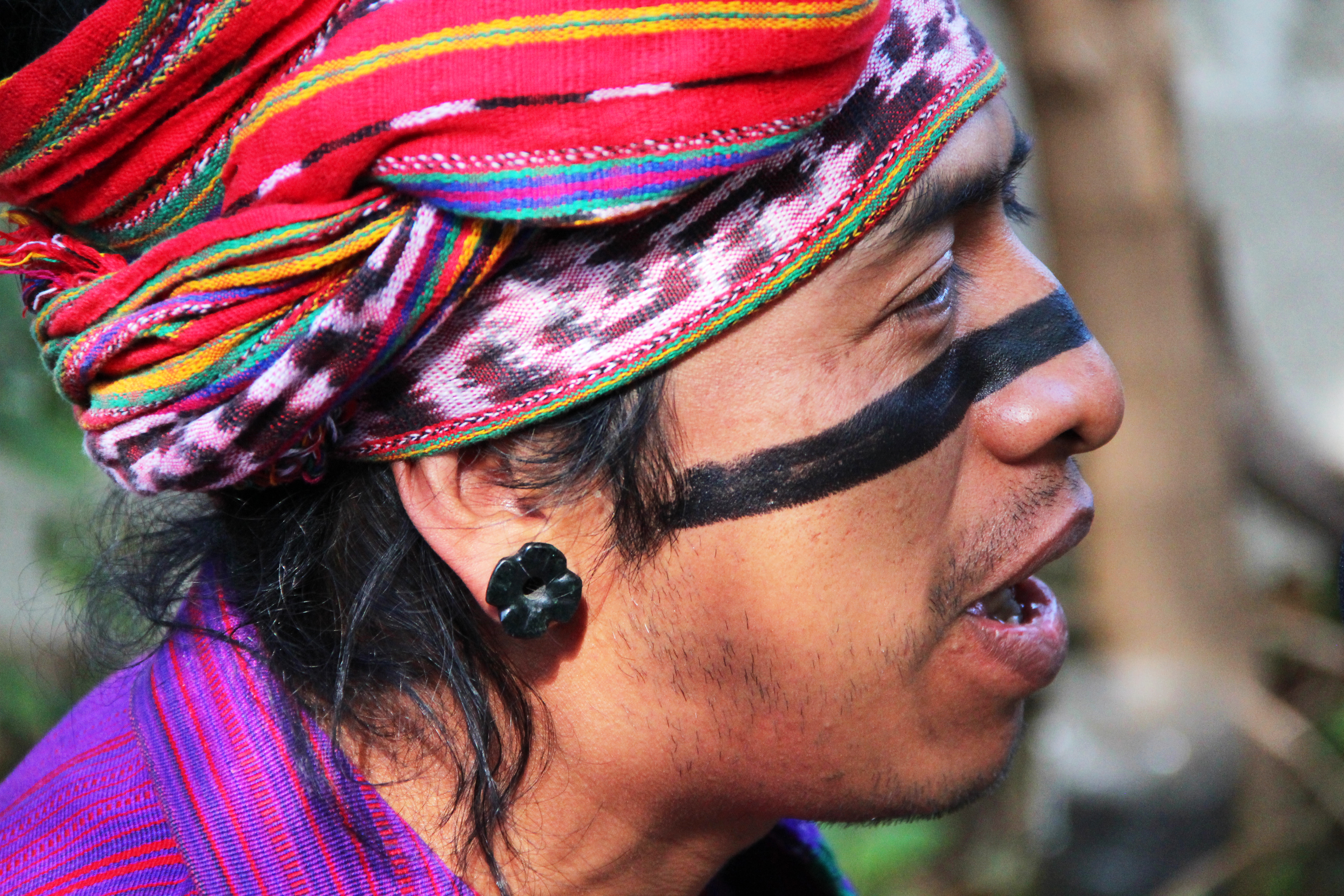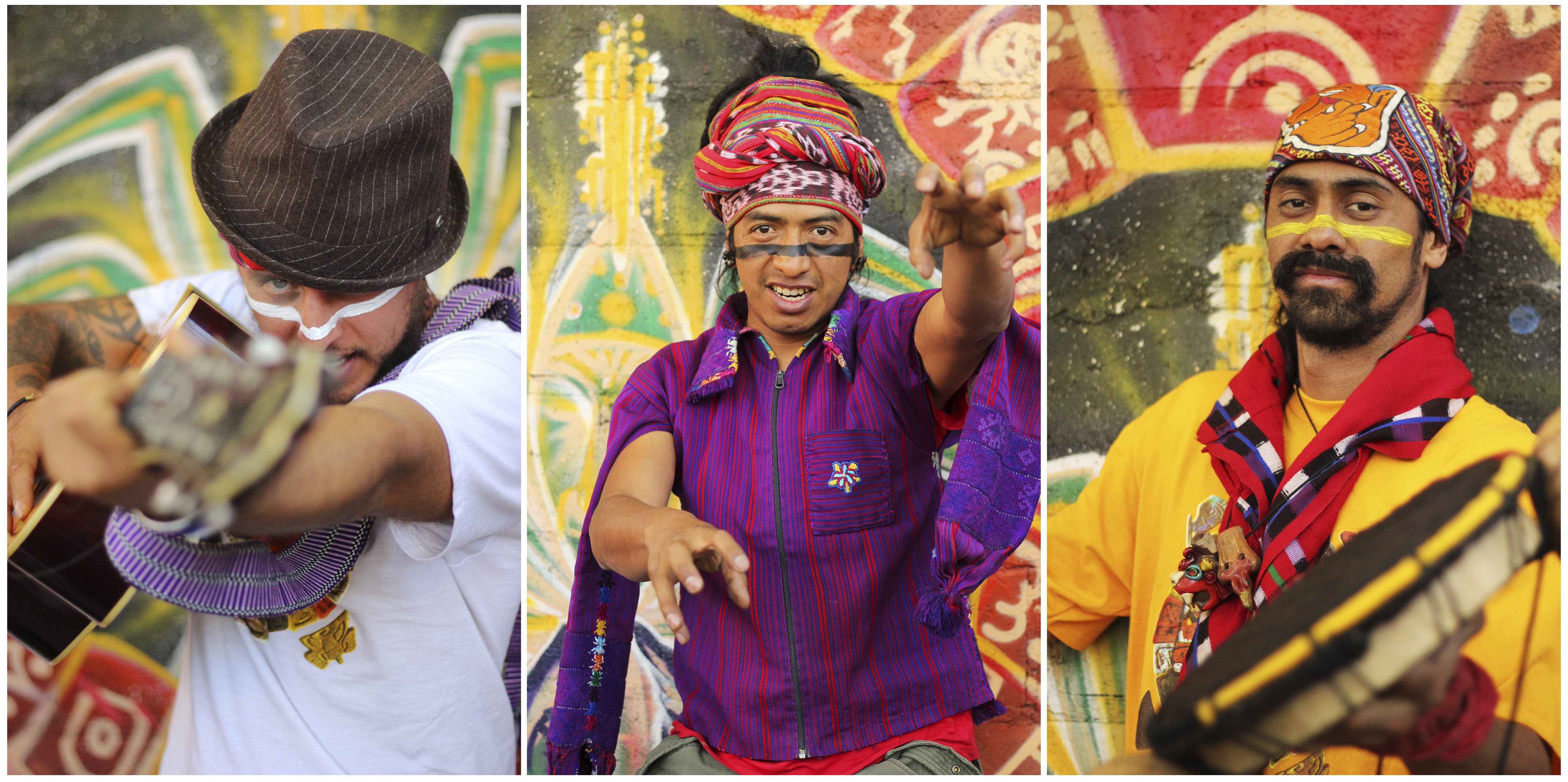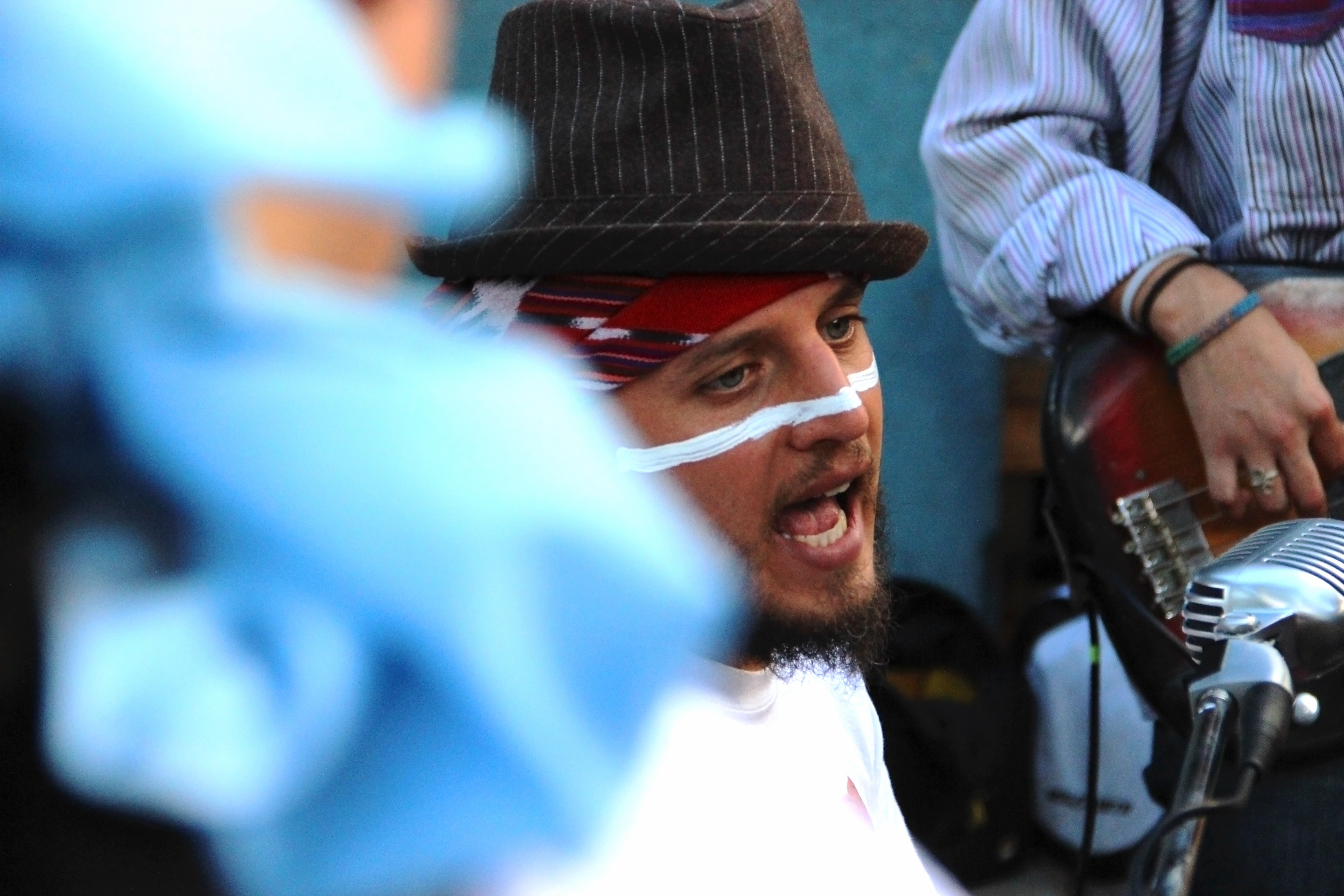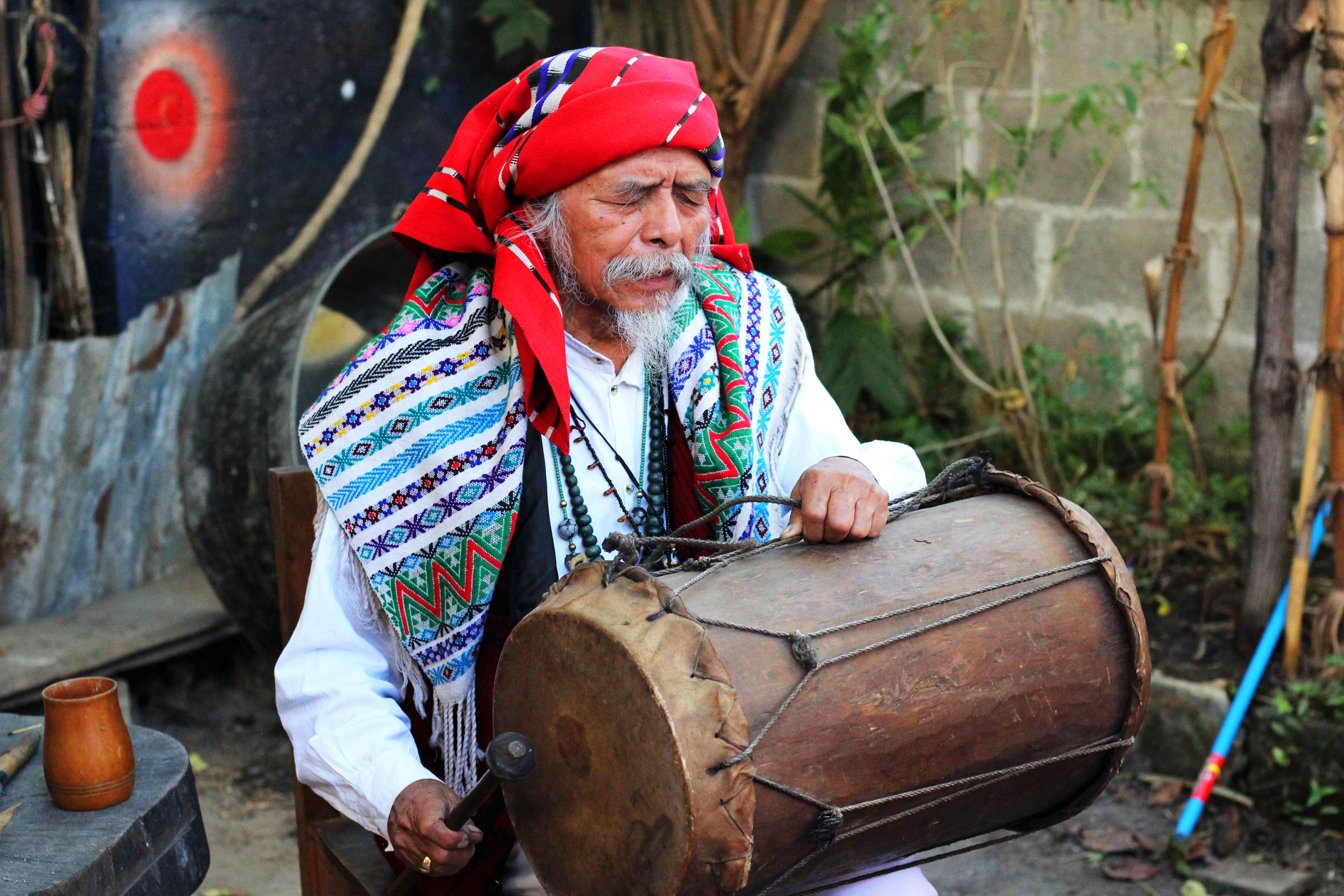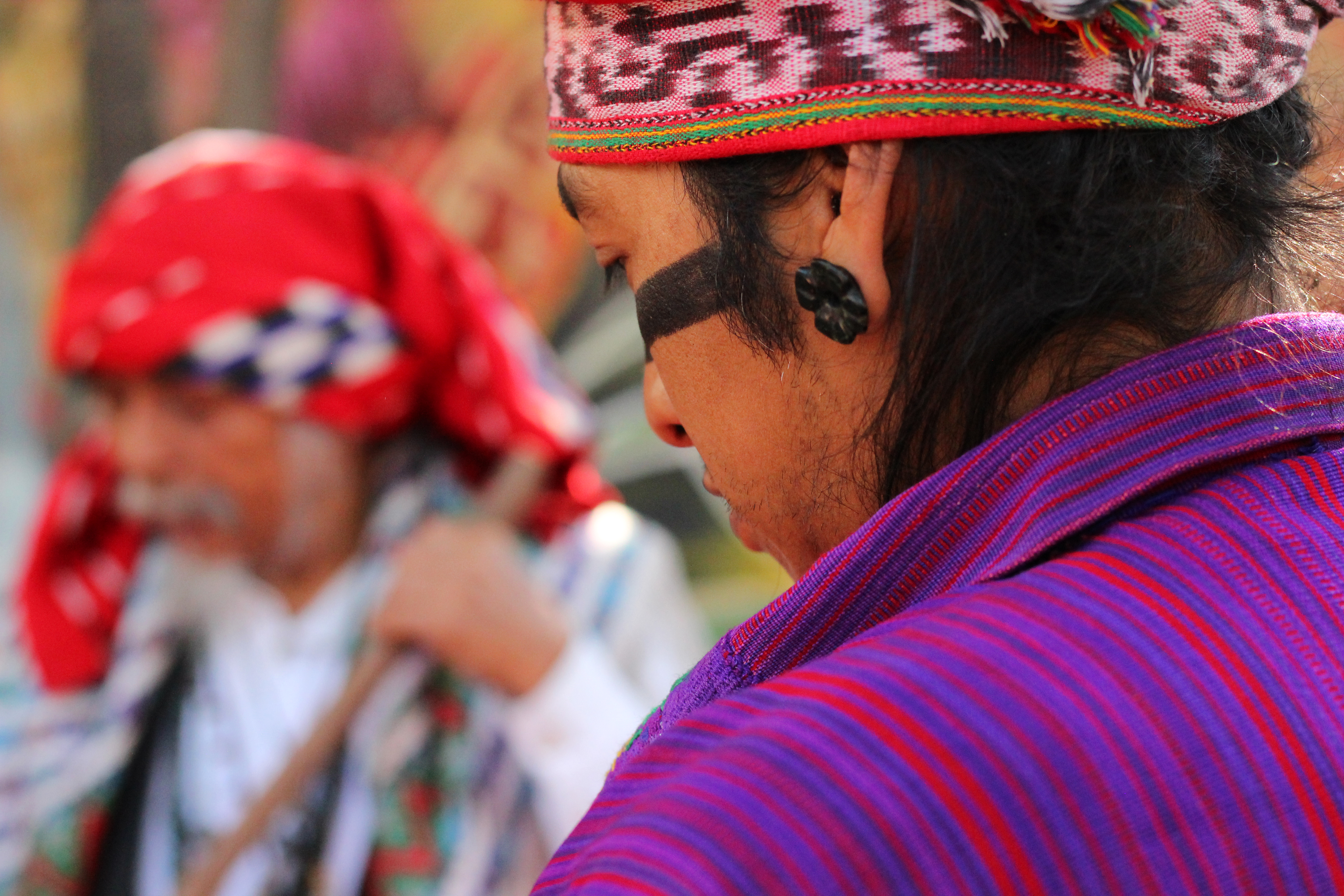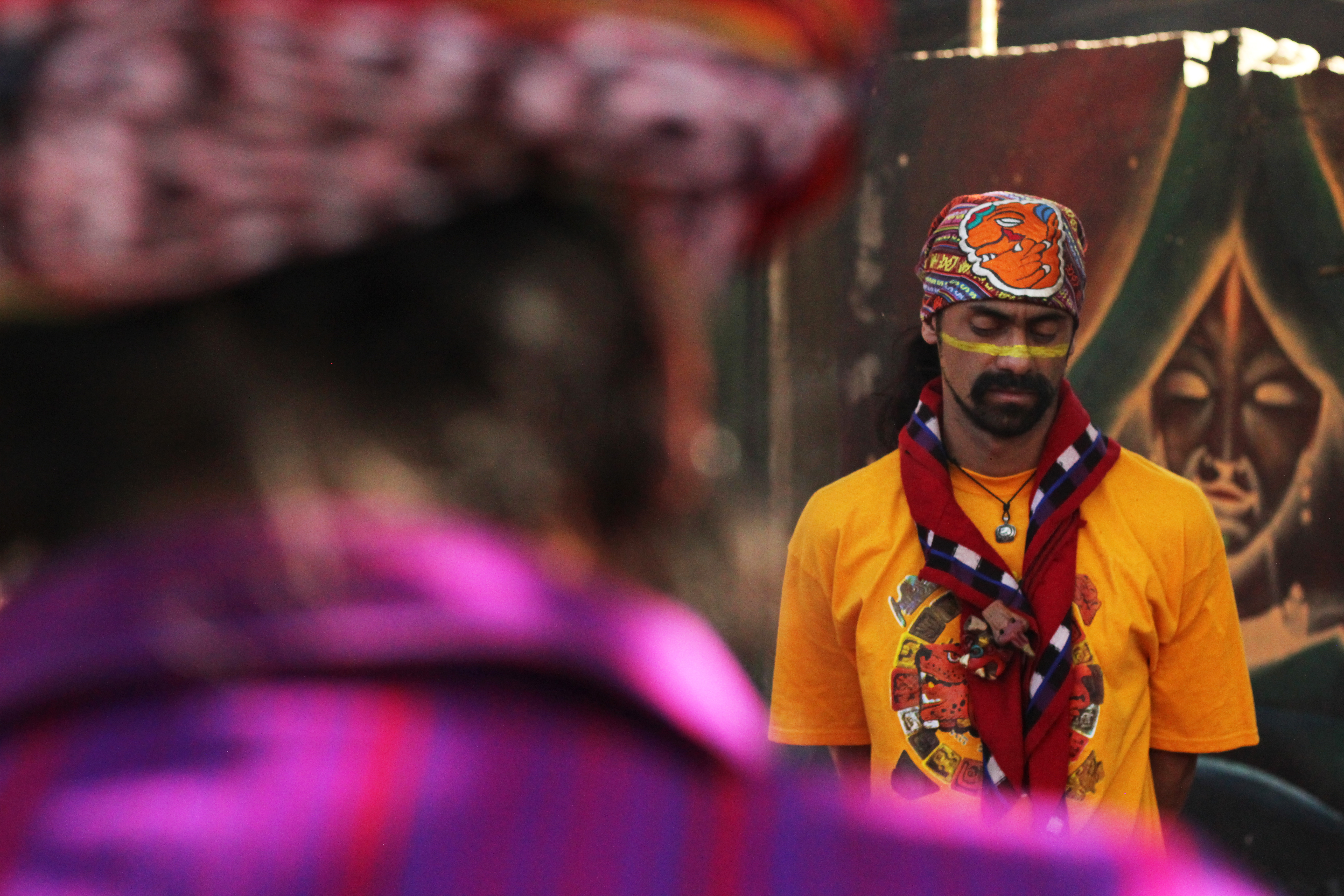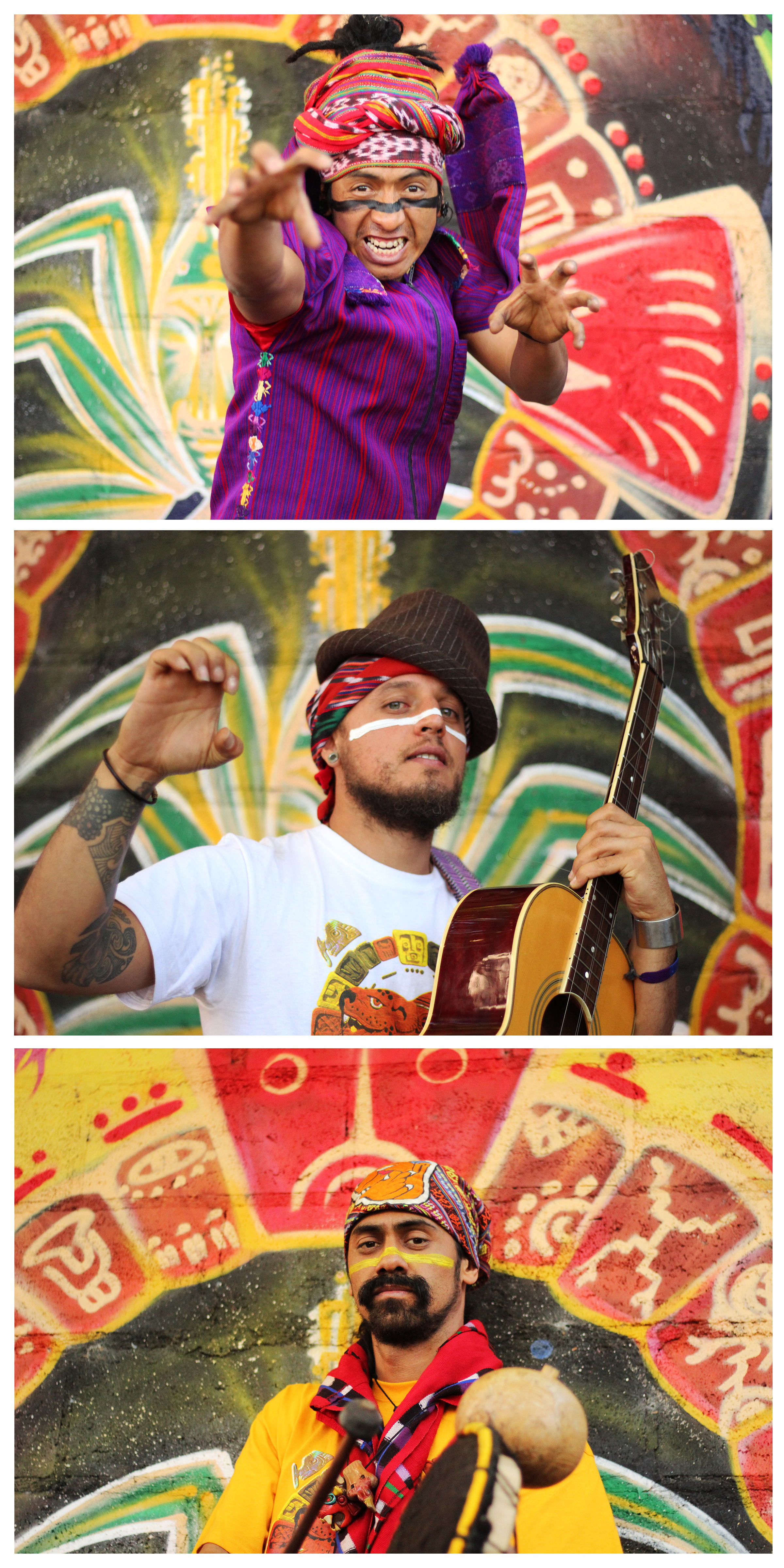“They appeared as if in a dream
at the top of the dune, half-hidden
in the cloud of sand rising from their steps.”
—”Desert,” J.M.G. Le Clézio
The first time I saw the members of Balam Ajpu perform together was in 2012, in Guatemala City, for the ZONA M’s closing show. They put on an unforgettable show.
Tzutu, Nativo, and MChe walked onto the stage slowly, like a gentle mist, while shaking their sonajas and blowing incense. People watched silently, as though in a daze. White fog covered the steps. When the smoke cleared, Tzutu was kneeling down, lighting a small fire while reciting Mayan poetry. Soon that spiritual opening turned into a furious hip-hop concert.
Despite the language difference—Tzutu was rapping in Tz’utujil—his fiery, speedy rapping infected the crowd, which began dancing, bobbing their heads, and clapping along. Tzutu howled, screamed, and strained his voice. It was powerful and hypnotizing; larger than life. There were handmade shakers, empty turtle shells, wooden drums, songs in Spanish, Mayan, Tz’utujil. So unlike what we were used to at a rap concert.
All of Balam Ajpu’s shows are that memorable. Far from a typical hip-hop recital, theirs is a ceremony, a rebellious spiritual gathering. Their lyrics are sincere tributes to the Mayan culture, Mother Nature, the forefathers and foremothers, the creators, the Earth, the stars, life. Their music: a fermented rendering of contemporary sounds. Marimbas, sonajas, turtle shells, hand-made drums, and birds chirping meet with acoustic guitars, basses, and violins to form slippery reggaes, smooth cumbias, and explosive Mayan raps.
A little after their 2012 show, the three musicians announced they were forming a group, Balam Ajpu (“jaguar warrior” in Mayan), to work on their first collaborative album. It was to be a tribute to the twenty nawales—the spiritual forces of nature that feed, control, balance, and protect the world, according to Mayan tradition.
Three years later, in early 2016, the band released Jun Winaq’ Kasawal Q’ij to wide acclaim. Jun Winaq’ comprises twenty songs—one for each nawal—in Spanish, K’iche’, Kaqchikel, and Tz’utujil. Last October, as part of a lengthy world tour to promote their work and Mayan culture, Balam Ajpu arrived in New York City. Our paths crossed again at Columbia University where I interviewed them.
For the members of Balam Ajpu, their artistic brotherhood is not a coincidence. The fact that a green-eyed white man (Nativo), a mestizo (MChe), and a Mayan descendant (Tzutu) began making music together is far from a happenstance. The music they make, the countries they’ve been to, and the fact that now they play together was something decided by the nawales.
“Before the ZONA M show (in early 2012), I was in Mexico,” Tzutu said. “Nativo had his band. MChe was in Atitlán. We were all in different places, doing different things. But we were called to play together, to do this album, to make these songs.”
Tzutu returned to Guatemala mid-2012. He had planned to ask MChe and Nativo to do something together, anything. Later he found out that the other two hoped for something similar. Around that time their spiritual guides asked them to do the tribute to the twenty nawales. “That was our confirmation,” said Tzutu, smiling.
The three began working on their debut album on December 18, 2012; 1 Naoj in the Mayan calendar. The pre-production for Jun Winaq’ was unlike that of any other hip-hop album.
“We couldn’t just make up the lyrics,” Nativo said. “What’s on the record is what the nawales wanted us to say about them.”
For the writing process Tzutu, MChe, and Nativo gathered in front of Ta Nacho Morales, a Mayan priest who would summon the holy spirits, go into trance to “download” the information from the spiritual world, and recite what the nawales told him. The rappers would write down the messages and later interpret them along with their spiritual guides. The first ten nawales “descended” during that first session, on December 18. Thirteen days later, the remaining ten followed.
Once the lyrics were invoked and written down, the band worked on the music. The band members went to Lake Atitlán to adapt the lyrics. Nativo began strumming his guitar while Tzutu and MChe worked to fit the words inside the structure of the song.
The music made for the album was not just to escort the lyrics; every instrument recorded was meticulously chosen to fit the message and the meaning of each nawal. For example, the first track, Bat’z—the nawal that symbolizes the beginning of time– features a flute that represents the native element of the song and a handmade tun that represents that passage of time. Every song has specific instruments, sounds, and artifacts suggested by spiritual guides in order to rightly represent the nawal’s meaning and purpose. Grupo Sotz’il, an artistic collective that also seeks to promote Mayan culture through art, played most of the instruments on the record.
Another important element was the sounds of the animals each nawal represents. Throughout the album, we can hear armadillos, jaguars, woodpeckers, turtles, bats, snakes, owls, coyotes, howling monkeys, and the flapping wings of a hummingbird. This allows the songs to form mythological landscapes in which all the elements of each nawal are represented: the personality, message, history, and its physical counterpart. These sounds add a theater-like quality to the album, as though the album is not just a recording but also an artistic happening, close even to a musical.
The rappers’ voices also have specific tasks in the songs. Nativo’s choruses explain the nawales’ essence. MChe’s verses (in Spanish) talk about the origin of the nawales, about their birthplace, the animals they represent, and their meaning. Tzutu’s addresses the nawal directly, gives offerings, and asks permission to talk about them.
Mayan culture has been trampled on and silenced by over five hundred years of conquest, slavery, racism, civil war, and genocide. Balam Ajpu is among the few contemporary acts that have been sharing Mayan history and art openly in recent history, next to other young artists such as singer Sara Curruchich, poet Esteban Sabino, or the art collective Grupo Tzotzil, to name a few. For Mayan authorities, Balam Ajpu’s work is urgent, important, and truthful, despite their “unusual” delivery.
“Some didn’t like what we were doing,” said Nativo. “They even seemed insulted. I mean, look at me, white and green-eyed. They asked, what do I know about Mayans. But most people now don’t even look at the genre; they’re interested in the message and that we deliver it truthfully.”
In fact, the highest Mayan authorities in the country endorse Balam Ajpu. “I think they look past the fact we’re rapping and just focus on the message,” MChe said.
The result is a powerful, dramatic, and smooth rap record. The twenty tracks of Jun Winaq’ display a wide array of musical genres, bound together by the wit, agility, and artistry of Balam. Furious raps, charming reggaes, and slick cumbias—all heavily seasoned with traditional Mayan artifacts and nature sounds—make Balam Ajpu’s debut an epic, joyous, and eventful gathering.
Songs like “Aj” or “Tz’ikin” show the band’s craftsmanship, blending hip-hop, acoustic reggae, and Mayan mythology. “Iq” and “Bat’z” are perfect examples of how their music is equally mysterious and numinous; despite not being actual ballads, some of these songs seem to be carried by the wind. And then there are those like “Tijax,” “Ajpu” and “Tzi’”: powerful and destructive.
Balam Ajpu’s unmistakable flow, punch, and delivery carry the sincerity of acts such as Manu Chao, Victor Jara, Matisyahu, Rage Against the Machine, and Tinariwen. Their music is a solemn tribute to life and culture, a mix between tradition and originality.
Part of Balam Ajpu’s challenge is to connect with the crowd, not just musically, but spiritually and intellectually. It’s not just about making people dance and sing, but educating them as well. “What we usually do,” said Nativo, “is make people sing certain sacred words. They’re not saying hello, or party. They’re saying Ajmaq: one of the twenty nawales, it represents the sin and forgiveness, the darkest night and the first ray of light. When people feel our passion, they offer theirs.”
Balam Ajpu feeds off this connection too; their dialogue with the audience is part of their own education. The band’s ability to adapt to different situations and idiosyncrasies has enriched their musical knowledge, broadened their cultural understanding, and allowed them to sympathize with people all over the world.
“We have been able to share with native people from across the world,” said Tzutu, “and I can tell you that the struggle is similar. We’ve learned much from them—not just how to deal with oppression but how to organize and how to love and respect each other.”
Just last year the band went to Norway for the Riddu Riddu festival, where they had a chance to meet Sámi people, along with other natives who attended the festival. The Sámi in Norway have their own indigenous parliament and have fought for their territory like many other native communities. “And they’re white; you wouldn’t think of a white native,” Nativo said, smiling. “They’re a great example for us: they have fought for their land. They have fought for the animals and for their language to stay alive, and when I say that they have fought, it’s because they’ve also been oppressed and persecuted. They are a great example for native people all over the world.”
Tzutu, MChe, and Nativo believe in this cultural commitment to keep Mayan history and ideals alive and relevant. “If we don’t share it, if people stop talking about it, it dies,” said MChe. “And for us, it’s not only to simply share it. The Mayan tradition offers important tools about everyday life, health, and spirituality.”
According to the band, the whole world can learn from the Mayans: their agricultural knowledge, respect for women and ancestors, humility. “The Mayan calendar is, by the way, more precise than the Gregorian calendar,” said Tzutu. “Their story is full of historical and racial lessons, too. Sacred Mayan objects were stolen and are now scattered around the world. Land continues to be exploited without permission. Mayan people are still discriminated [against]. World leaders have to respect the millennia-old lands of natives, whether [it] is Mayan, Aztec, Sámi, or Native American. We can all learn from what our ancestors have gone through.”
Their songs, albums, and shows are only a part of how Balam Ajpu delivers their earnest message to the people. One of the most important pillars of their work comes from the Casa Ajaw, the first Mayan hip-hop school in Guatemala, founded in 2012 near Lake Atitlán. “People in Guatemala are desensitized and don’t care about their natives, about the indigenous people,” Nativo said. “But if we can positively affect a new generation, it’ll spread, and, maybe in the not too distant future, we can live in a more inclusive society.”
Children at Casa Ajaw learn agriculture, Mayan languages, the country’s history, and how to express themselves through art. One of their must important projects is the musical adaptation of Genesis according to the Mayan Bible, the Popol Vuj. Balam Ajpu members are currently working on a country-wide implementation of a school curriculum, founding a Mayan parliament, promoting the Mayan calendar—and, of course, disseminate their album.
Just a few weeks ago, in early January, Balam Ajpu got together with Guatemalan art magazine esQuisses for a live recording session. After a four-hour drive from Guatemala City to Sololá, and another hour down into San Pedro, the band reached the home of another important Mayan priest, Ta Pedro Cruz.
In front of Ta’s shrine, on his backyard—where they would eventually perform—the band set up their instruments, painted their faces, and decided which songs to play.
“We have to play “Kan“; today’s Kan,” said Nativo, tuning his guitar.
After the band set up the gear and tuned the instruments, Ta Pedro conducted an offering with fire, candles, sugar, and tobacco. Ceremoniously dressed for the occasion, he thanked the gods for the new day and blessed the musicians and crew—the fire crackling as though marking the beat. The band played “Kan,” “Saq B’ey,” “Ix,” “Imox“; Ta Pedro smoked and silently prayed during the recording.
Soon the band will release Nativo’s album GuateMAYA in New York, featuring his greatest hits. Then, all three members of Balam Ajpu will begin the pre-production of their next album: another twenty-track epic with each song written in a different indigenous language. The band has talked about this with the Guatemalan Academy of Mayan Languages. This year will take Balam Ajpu to Mexico and New York for promotion and then back to the Guatemalan highlands for research.
After two hours of recording, Ta Pedro wrapped the ceremony with a chant of his own, and put out the fire before thanking us for the visit, waving us off into the misty mountains of Sololá.
In Guatemala, where indigenous people are still widely and openly ignored or underappreciated, artists like Tzutu, MChe, and Nativo regenerate the native culture with courage and potency. But they’re not just cultural ambassadors, they’re a true creative powerhouse. Their work, among hip-hop’s contemporaneity, is unique, and their message is urgent and full of wisdom.
